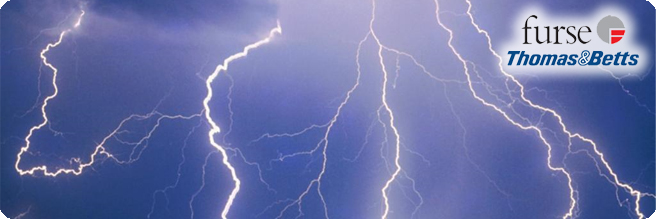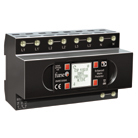|
|
||||||||
|
Furse Earthing and Lightning Protection
and Electronic Systems Protection by Thomas & Betts
How to get Effective Protection
CompatibilityThe protector must not interfere with the system’s normal operation:
SurvivalIt is vital that the protector is capable of surviving the worst case transients expected at its installation point/LPZ boundary. More importantly, since lightning is a multiple event, the protector must be able to withstand repeated transients. The highest surge currents occur at the service entrance (boundary LPZ 0A to LPZ 1). For buildings with a structural LPS, the lightning current SPD could be subject to as high as 25kA 10/350μs surge currents per mode on a 3-phase TNS mains system (up to 2.5kA 10/350μs per mode on a signal or telecom line) for a worst-case lightning strike of 200,000A. However, this 200kA level of lightning current itself is extremely rare (approx. 1% probability of occurring) and the peak current the SPD would be subject to further assumes that a structure is only fed with one metallic service. Almost all structures have several metallic services connected to them such as gas, water mains, data & telecoms. Each service shares a portion of the lightning current when the protected building receives a strike, greatly reducing the overall current seen by any single service, and as such any SPD fitted to the electric service lines. Transient overvoltages caused by the secondary effects of lightning are considerably more common (lightning flash near a connected service up to 1km away from the structure) and therefore are unlikely to have currents exceeding 10kA 8/20μs. Let-through voltageThe larger the transient overvoltage, the greater the risk of flashover, equipment interference, physical damage and hence system downtime. Therefore, the transient overvoltage let through the protector (also known as the protection level Up of the SPD) should be as low as possible and certainly lower than the level at which flashover, interference or component degradation may occur. Transient overvoltages can exist between any pair of conductors:
Thus, a good protector (enhanced SPDs to BS EN 62305) must have a low let-through voltage between every pair of conductors. Enhanced performance SPDs - SPD*BS EN 62305-2 details the application of improved performance SPDs to further lower the risk from damage. The lower the sparkover voltage, the lower the chance of flashover causing insulation breakdown, electric shock and fire. SPDs that offer lower voltage protection levels further reduce the risks of injury to living beings, physical damage as well as failure and malfunction of internal systems. All Furse ESP protectors offer such superior protection and are termed as enhanced performance SPDs (SPD*) in line with BS EN 62305. Enhanced SPDs can also satisfy more than one test class/category by handling both high-energy partial lightning currents of 10/350μs waveshape whilst offering very low let-through voltages. Such enhanced SPDs may be suitable for changing a lightning protection zone from LPZ 0A right through to LPZ 3 at a single boundary or installation point. As such they provide both technical and economic advantages over standard SPDs. End of lifeWhen an SPD comes to the end of its working life it should not leave equipment unprotected. Thus in-line protectors should take the line out of commission, preventing subsequent transients from damaging equipment. SPDs for data communication, signal and telephone lines and protectors for low current mains power supplies are usually in-line devices. Where SPDs are installed at mains power distribution boards it is usually unacceptable for these to suddenly fail, cutting the power supply. Consequently, to prevent equipment being left unprotected, the SPD should have a clear pre end-of-life warning, which allows plenty of time for it to be replaced. InstallationThe performance of SPDs is heavily dependent upon their correct installation. Thus, it is vital that SPDs are supplied with clear installation instructions. The following is intended to supplement the detailed guidance given with each product in order to give a general overview of installation. This should not be viewed as a substitute for the Installation Instructions supplied with the SPD. Copies of these are available separately on request. Installing parallel connected SPDs for mains power supplies:
Installing in-line SPDs for data, signal, telephone or power:
When & Where to Protect
Transient overvoltages are
conducted into the sensitive circuitry of electronic equipment
on power and data communication, signal and telephone lines.
Protection is recommended for:
Protect incoming and outgoing electrical servicesLightning strikes between clouds or to ground (and objects upon it) can cause transient overvoltages to be coupled onto electrical cables, and hence into the sensitive electronic equipment connected to them. To protect the electronic equipment inside a building, all cables that enter or leave the building must be protected. Cables leaving the building can also provide a route back into the building for transients. For each building protect incoming/outgoing:
Protect the power supply locally to important equipmentIn addition to installing protection on the mains power supply as it enters/leaves the building, protection should also be installed locally to important equipment. Protection at the main LV (low voltage) incomer(s) is necessary to prevent large transients from entering the building’s power distribution system, where they could have farreaching effects. However, where the cable run to equipment exceeds approximately 20 metres, transient overvoltages may appear on the mains after the protector at the main LV incomer. These transients can result from:
Additionally, local protection guards against the possibility of a supply which enters/leaves the building being overlooked and left unprotected. Protect data lines locallyGenerally, the biggest risk to data, signal, telecom and network wiring is associated with cables that enter and leave the building. These should always be protected. However, data cables within a building can additionally have transients induced on to them when loops between data and power cables “pick up” voltages from the magnetic field caused by a lightning strike. As part of the overall LEMP Protection Measures System (LPMS), BS EN 62305 advocates the use of metal in the structure, and a Faraday cage lightning protection scheme to help exclude magnetic fields. Cable management practices eliminate loops by routeing data and power cables along the same general path. In these cases, the need for local data line protection is minimal. However, where these steps are not possible, data line protection, local to the equipment requiring protection, should be considered. Protect electronic equipment outside the buildingOnsite or field-based electronic equipment with mains power, data communication, video, signal or telephone line inputs will need to be protected against transient overvoltages. It may be helpful to think of each equipment cabinet or cubicle as a separate building with incoming/outgoing cables to be protected. Complementary techniquesAs well as
the use of transient overvoltage protectors, BS EN 62305
outlines additional protection techniques, which can be used to
help reduce the transient threat as part of the overall LPMS.
These are described further in the Furse document “A Guide to BS
EN 62305:2006 Protection Against Lightning.” Where these can be
used, principally on new build or refurbishment projects, they
need to be supported by
ESP Product Selection |
|||||||
|
|
|
Etech Components, Unit 14 Park Court, Sherdley Business Park, Sullivans Way, St.Helens, Merseyside, WA9 5GZ |
|

 Transient
overvoltages are short duration, high magnitude voltages peaks
with fast rising edges, also known as surges. Often described as
a 'spike', transient voltages can reach up to 6000V on a
low-voltage consumer network, with no more than millisecond
duration.
Transient
overvoltages are short duration, high magnitude voltages peaks
with fast rising edges, also known as surges. Often described as
a 'spike', transient voltages can reach up to 6000V on a
low-voltage consumer network, with no more than millisecond
duration. In
order to provide effective protection, a transient overvoltage
protector/SPD must:
In
order to provide effective protection, a transient overvoltage
protector/SPD must:
 We’ve
seen how protection should be installed on all cables which
enter or leave the building (except fibre optic); the power
supply local to important equipment; electronic equipment
outside the main building(s).
We’ve
seen how protection should be installed on all cables which
enter or leave the building (except fibre optic); the power
supply local to important equipment; electronic equipment
outside the main building(s). All
Furse ESP products are designed to provide simple system
integration whilst achieving highest levels of effective
protection against transients.
All
Furse ESP products are designed to provide simple system
integration whilst achieving highest levels of effective
protection against transients.